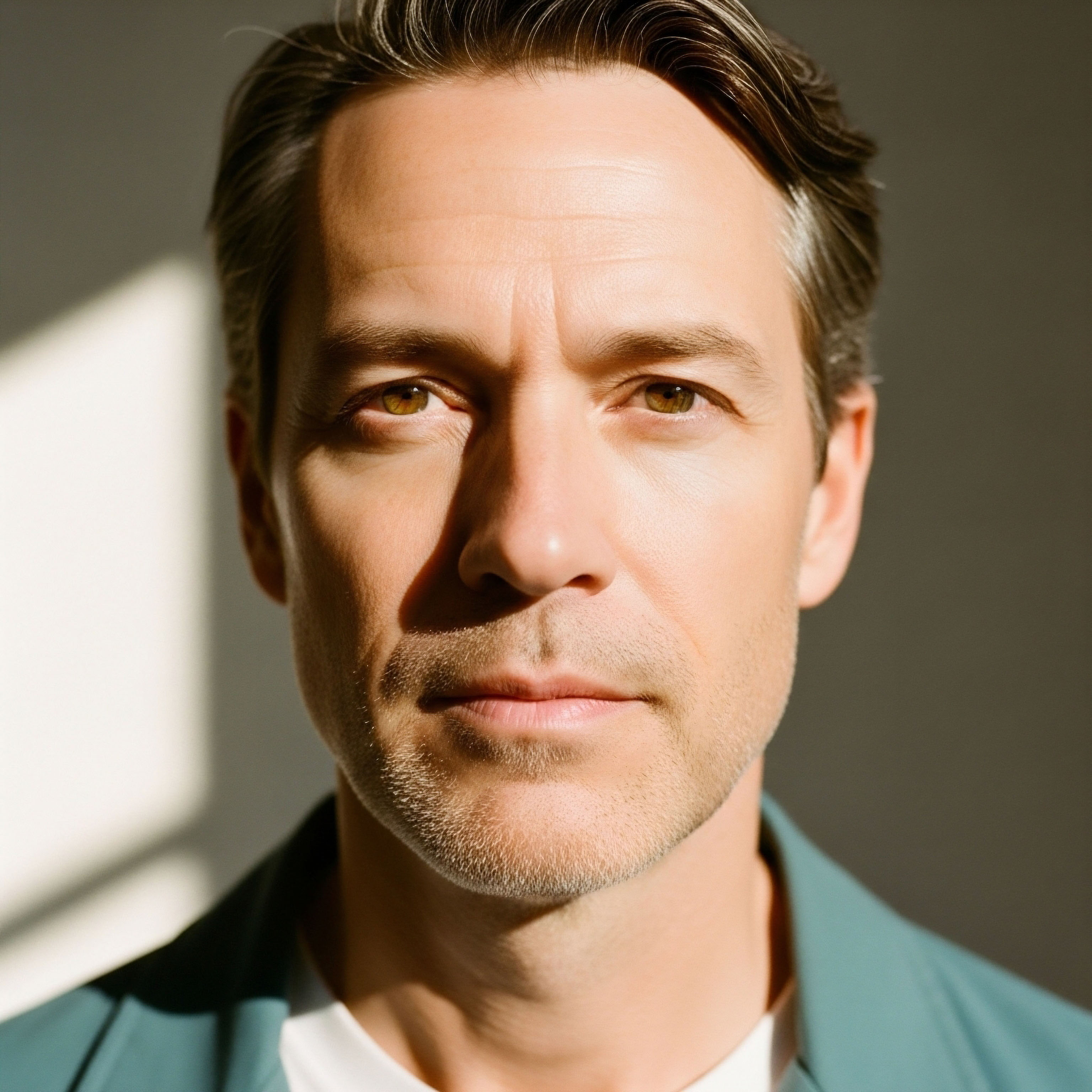

The False Horizon of Inevitable Decline
The default narrative of aging is a myth of surrender. Society has conditioned the high-performer to view performance attenuation ∞ the loss of drive, the shift in body composition, the mental drag ∞ as an unalterable contract with the calendar. This passive acceptance is a cognitive error, a fundamental misdiagnosis of a solvable problem. The biological reality is that age-related performance declines stem from a measurable, targeted undershoot in core endocrine and metabolic systems.
The system does not simply fail; it runs out of its high-grade operational fluid. The issue is a signal failure, a reduction in the concentration of the master molecules that command tissue repair, metabolic speed, and neural communication.
We observe the symptoms ∞ the loss of muscle mass, the accumulation of visceral adipose tissue, the degradation of deep sleep cycles ∞ and label it “getting older.” The Clinical Architect identifies the true causal mechanism ∞ a decline in the HPG axis output, a loss of cellular insulin sensitivity, and a reduction in endogenous growth factors.

The Data Point of Diminished Command
Consider the central role of free testosterone and bioavailable growth hormone. These are the command-and-control molecules for human vitality. Their concentration dictates the anabolic state of the musculoskeletal system, the speed of injury recovery, and the sheer force of psychological drive. When these signals recede, the body shifts its priorities from maintenance and growth to conservation. This is a predictable, linear process, which means it is also a predictable, linear target for correction.
For men, a 50% drop in free testosterone levels between age 25 and 75 is a conservative estimate, directly correlating with reduced muscle protein synthesis and decreased bone mineral density.
The core principle remains ∞ the symptoms of decline are data points, not destiny. A high-performance mindset demands a shift from managing symptoms to optimizing the root cause. This requires looking past the general practitioner’s range of ‘normal’ and targeting the optimal physiologic zone for peak human function.

The Energy Drain Is Biochemical
Mental clarity and motivation are fundamentally energetic states driven by cellular metabolism. As mitochondrial efficiency wanes and the body’s sensitivity to insulin decreases, the brain and muscle tissues starve for efficient fuel delivery. The resulting brain fog, lethargy, and lack of spontaneous drive are biochemical expressions of a systemic metabolic deceleration. Performance recovery becomes slow because the cellular machinery for repair is operating at a reduced capacity, not because the individual lacks discipline.


The Precision Chemistry of Systemic Upgrade
The pathway to redefining performance involves a methodical, evidence-based intervention on the key regulatory systems. This is not guesswork; it is the applied science of endocrinology and performance pharmacology. We approach the body as a complex system requiring targeted, high-purity inputs to restore optimal signal strength. The methodology is tripartite, addressing the core hormonal axis, the cellular signaling pathways, and the metabolic foundation.

Recalibrating the Endocrine Axis
Hormone Replacement Therapy (HRT), specifically Testosterone Replacement Therapy (TRT) for men and optimized hormone protocols for women, functions as the primary signal restoration tool. This intervention restores the foundational anabolic signal required for protein synthesis, mood stability, and optimal red blood cell production.
- Restoration of Signal Strength ∞ External administration of bioidentical hormones brings serum levels back into the high-optimal range, overcoming the age-related feedback loop failure of the HPG axis.
- Body Composition Reset ∞ Elevated anabolic signals shift the body’s set point away from fat storage and toward lean tissue maintenance, creating a more metabolically efficient organism.
- Cognitive Uplift ∞ Optimized hormone levels support neuronal health, neurotransmitter balance, and myelin maintenance, directly addressing the common complaint of mental drag and diminished focus.

Targeting Cellular Communication with Peptides
Peptide science represents the next frontier in precise biological instruction. These short-chain amino acids function as superior signaling molecules, delivering specific instructions to cellular machinery. They bypass the blunt-force approach of older pharmaceuticals, targeting discrete functions like recovery, fat loss, and tissue repair with high specificity.
For instance, Growth Hormone Releasing Peptides (GHRPs) and Growth Hormone Releasing Hormone (GHRH) analogs do not simply introduce exogenous Growth Hormone. They act on the pituitary gland to amplify the body’s natural, pulsatile release of GH. This results in the benefits of improved sleep quality, enhanced tissue repair, and accelerated lipolysis without the side effects associated with non-pulsatile, high-dose exogenous GH administration.
The application of these agents is always layered upon a foundation of meticulous lifestyle controls:
- Metabolic Foundation ∞ Zero-tolerance policy for insulin resistance, managed through precise dietary carbohydrate timing and extended fasting protocols.
- Sleep Architecture ∞ Non-negotiable eight hours of high-quality sleep, leveraging peptide support (like BPC-157 for gut health and recovery) and sleep-hygiene protocols to optimize REM and deep-wave cycles.
- Resistance Training ∞ A minimum of three sessions per week focused on heavy, compound movements to maximize the anabolic stimulus that the optimized endocrine environment can utilize.


Chronos versus Kairos a Timetable for Renewal
The commitment to performance optimization requires an understanding of the timeline ∞ the difference between Chronos (linear, clock time) and Kairos (the right, opportune moment for action). The interventions are immediate, but the full expression of the biological upgrade is phased, dictated by the half-lives of the molecules and the rate of cellular turnover. This is a phased execution, not a sudden transformation.

Phase I the Endocrine Recalibration Window
The initial weeks (Weeks 1-4) are characterized by the rapid restoration of hormonal signal strength. Subjective improvements in energy, mood stability, and libido are often the first to surface as serum hormone concentrations reach the therapeutic range. Sleep architecture begins to improve as the central nervous system benefits from optimized signaling. This initial phase is crucial for establishing the psychological momentum required for sustained effort.
Clinical trials show significant improvements in mood, vitality, and sexual function metrics within the first 6-12 weeks of optimal hormone replacement protocols.

Phase II the Morphological and Metabolic Shift
The next period (Weeks 4-12) marks the onset of tangible physical changes. The restored anabolic environment, coupled with the intensified resistance training, begins to drive measurable changes in body composition. Muscle protein synthesis accelerates, and the body becomes highly responsive to fat loss efforts. This is the period when the metabolic system truly begins to operate with superior efficiency. This shift is visible in improved fasting glucose, better lipid panels, and reduced inflammation markers.

Sustained Optimization the Long-Term Horizon
Beyond the three-month mark, the protocol shifts from restoration to sustained optimization. The body has established a new, elevated physiologic set point. The focus becomes data-driven maintenance:
Routine blood panels (every 3-6 months) are mandatory for precision dosing adjustments. The goal is to hold the key performance indicators ∞ free hormones, metabolic markers, and inflammatory indices ∞ within the optimal therapeutic range. This long-term commitment is the ultimate differentiator between the casual wellness enthusiast and the serious Vitality Architect. The sustained result is not merely an absence of decline, but an upward trajectory of function that redefines the latter decades of life.

The Unacceptable Ceiling of Complacency
The true cost of age-related performance decline is not measured in lost muscle or diminished energy. It is measured in lost potential, in the creative and professional output that never materialized because the underlying biology was operating at a suboptimal level. We accept a ceiling of function that is demonstrably beneath what modern science permits.
The path forward is clear ∞ a proactive, data-led, and scientifically rigorous intervention on the human system. The body is the most sophisticated piece of equipment a person will ever possess. Treating it with anything less than a master engineer’s precision is the only real failure. The future of human performance belongs to those who refuse the false narrative of surrender and demand a biological system that executes at its absolute best.



